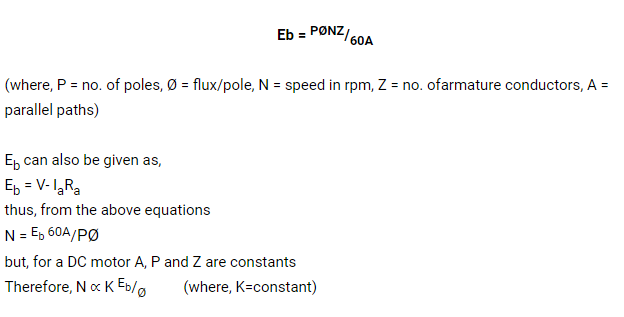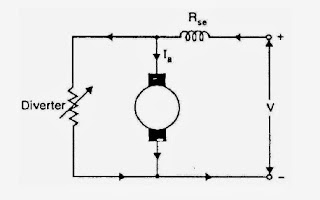As discussed speed of a dc motor is directly proportional to back e.m.f Eb where Eb = V – IaRa. By keeping V and Ra constant back e.m.f Eb depends on Ia.Add a resistance in series to the dc shunt motor armature as shown in the following circut.
Now by increasing the resistance current decreases.As current decreases back e.m.f Eb decreases. As back e.mf Eb decreases speed of the dc shunt motor decreases.
In this method the armature is supplied with variable voltage with the help of a suitable switch gear.The voltage across the shunt field is maintained constant. As the speed of dc shunt motor is directly proportional to voltage across the armature the speed of dc shunt motor can be controlled accordingly.
Here motor M1 drives the generator G. Motor M1 has constant speed. M2 is the motor whose speed is required to be controlled.Generator G is coupled to M2.Here the voltage from the generator G is supplied to armature of motor M2. The voltage supplied by the generator can be varied smoothly with the help of field regulator . So by
Ward – leonard system smooth
speed control of dc shunt motor is obtained.
Speed control of dc series motor:
There are three methods for controlling speed of dc series motor.
1. Flux Control Method
This is further divided into four types. They are
a) Field divertor.
b)Armature divertor.
c)Tapped field control.
d)Paralleling field coils.
2. Armature – resistance control.
3. Series – parallel control.
Speed control of dc series motor by flux control:
Let us discuss speed control of dc series motors by different flux control methods.
Speed control of dc series motor by flux control by using field divertor:
Here we connect a variable resistance in parallel with the series field of dc series motor as shown in the following circuit.
As we have connected a variable resistance in parallel with the series field some of the current that has to flow through series field is diverted to variable resistance( this is the reason why it is called divertor). So the current flowing through the series field decreases as current decreases flux decreases. We know speed of dc motor is inversely proportional to flux as flux decreases speed of dc series motor increases so we can achieve high speeds with this method of speed control of dc motor.
Speed control of dc series motor by flux control by using armature divertor:
In this method we connect a variable resistance parallel to armature of dc series motor as shown in the following circuit.
As we have connected variable resistance in parallel to armature the armature current Ia decreases.We know torque equation for a dc series motor is Ta ∝ ØIa. So for a constant load torque if Ia decreases flux Ø increases to maintain load torque constant. So the dc series motor draws more current from the supply so flux Ø increases as flux increases speed decreases as speed of dc motor is inversely proportional to flux. In this way the speed of dc series motor can be achieved by this method.
Speed control of dc series motor by flux control using tapped field control:
Here the series field winding has tapping as shown in the following circuit.
By selecting the suitable tap the number of turns connected in the circuit can be changed. We know speed of dc motor is inversely proportional to flux by changing the number of turns of series field connected in circuit the flux can be changed. If more number of are turns are connected to the circuit then current decreases so flux decreases. As flux decreases speed increases. If number of turns connected in the circuit are less current will be high. As current is high flux will be high so speed of dc series motor will be less. So according to the required speed we can choose the required number of turns and control speed of dc series motor.
Speed control of dc series motor by flux control using paralleling field coils:
Here the series field coils are regrouped and are connected in parallel as shown in the following circuit diagram.
As the series field winding is regrouped and connected in parallel the flux will decrease since current decreases.As speed of dc motor is inversely proportional to flux the speed of dc series motor will be high. According to the required speed i.e, high or less the coils are regrouped.
Speed control of dc series motor by armature – resistance control:
In this method we connect a variable resistance in series with the series field winding as shown in the following circuit.
By adding the resistance in series with the series field the voltage across the armature is reduced. As the speed of dc series motor is directly proportional to voltage across the armature the speed of dc series motor is reduced accordingly. This is the most common method for speed control of dc series motor.
Speed control of dc series motor by series – parallel control:
This method is generally applicable for electrical traction. For two or more dc series motors which are coupled this method is possible. In this method to gain less speeds the two series motors are connected in series. In series current is high(as current division is not there) we get high current as current is high flux is high. As speed of dc motor is inversely proportional to flux we get low speed. When the two dc series motors are connected in parallel the current is less( since current s divided between two series motors)as current is less flux is less so high speed is obtained. So according to the required speed we connect the dc series motors either in series or parallel. The circuit diagram for speed control of dc series motor by this method is shown below.
In this way speed control of dc series motor and dc shunt motor can be done.









